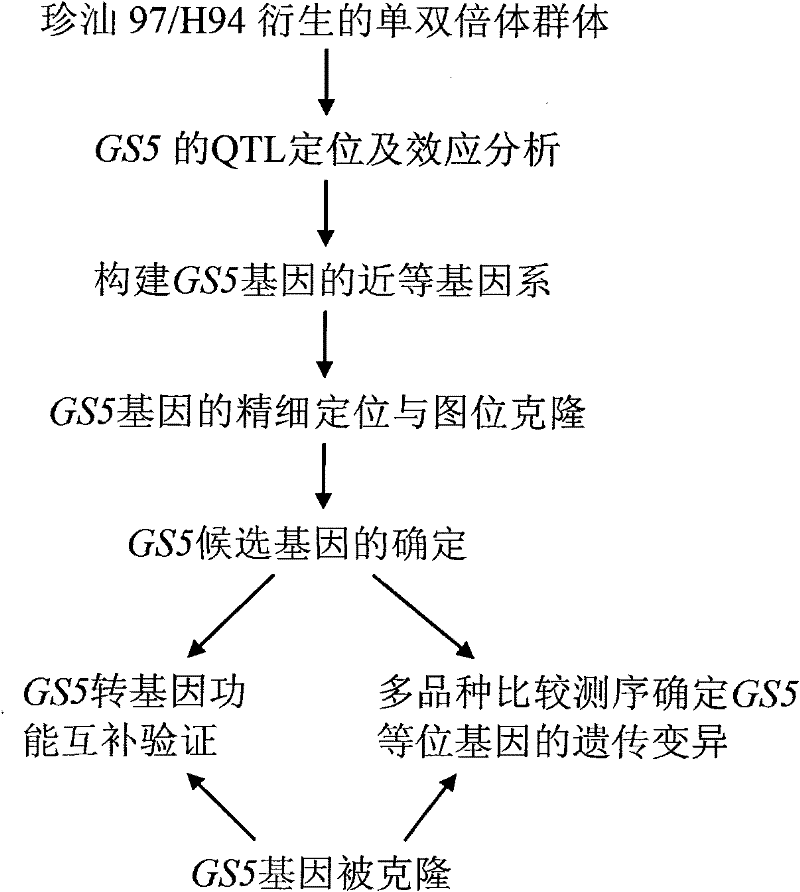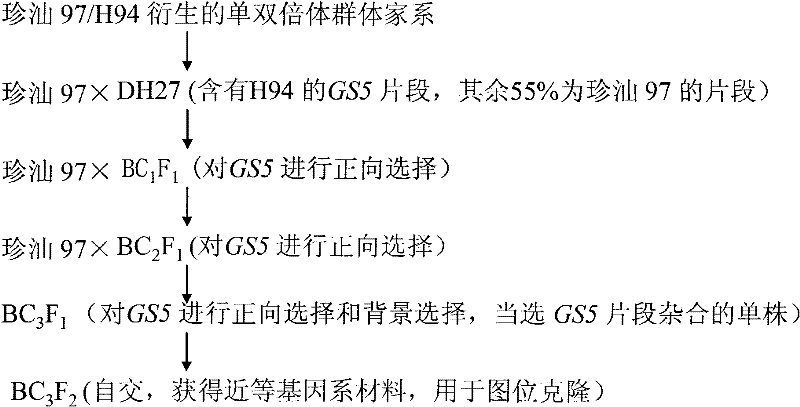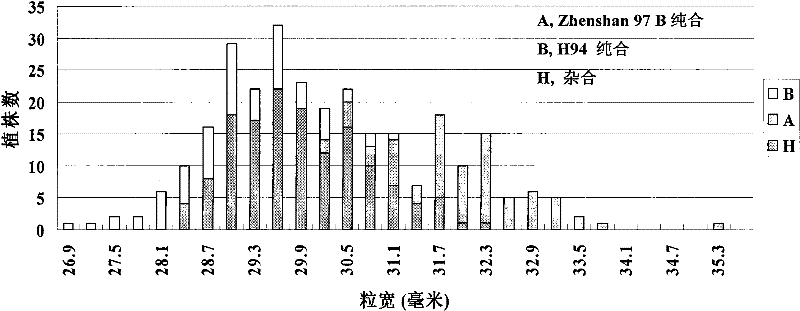Cloning and application of major gene GS5 capable of controlling width and weight of rice grain
A technology of major genes and grains, applied in the fields of application, genetic engineering, plant genetic improvement, etc., can solve problems such as QTL phenotypic trait interference
- Summary
- Abstract
- Description
- Claims
- Application Information
AI Technical Summary
Problems solved by technology
Method used
Image
Examples
Embodiment 1
[0029] Example 1: Construction of GS5 near isogenic line
[0030] 1 Backcross and selection
[0031] as attached figure 2 As shown, from the double haploid population derived from the combination of the wide-grain rice variety Zhenshan 97B and the narrow-grain variety H94, a family containing the GS5 gene and 55% of the genetic background is consistent with Zhenshan 97B was selected and crossed with Zhenshan 97B, Zhenshan 97B 97B is the reincarnated parent, backcrossed continuously for 3 generations, in BC 1 f 1 and BC 2 f 1 In the next generation, only positive selection was carried out on GS5, that is, individual plants whose target segment was Zhenshan 97B / H94 heterozygous genotype were selected for the next round of backcrossing. The target segment was identified in two SSR (Simple Sequence Repeat) markers RM593 and RM574 with reference to previous QTL mapping results (see: ( http: / / www.gramene.org / ) within the bounded range. Save BC 3 f 1 In the next generation...
Embodiment 2
[0035] Example 2: Fine mapping and map-based cloning of GS5
[0036] 1 grain wide phenotypic measurements
[0037] After the grains are naturally dried, they are placed at room temperature for at least 3 months to ensure the drying of the grains and the relative consistency of the water content among the strains. Randomly select 10 full grains from each individual plant, arrange them side by side in the same direction, without overlapping, and without gaps, and arrange them in a row, read the width with a vernier caliper, and find the average value to get the width of the grains . Grain thousand-kernel weight is estimated from the weight of 200 filled kernels randomly selected.
[0038] from BC 3 f 1 single plant derived BC 3 f 2 288 individuals were randomly selected from the population to form a random population. The grain width and other traits of each individual plant in Zhenshan 97B, H94 and random populations were investigated, and the genotypes of each plant wer...
Embodiment 3
[0047] Embodiment 3: Transgenic complementation test of GS5
[0048] 1 GS5 transgenic technology route:
[0049] Real-Time PCR expression profiling analysis found that the gene was expressed in various tissues during the whole growth period, and the expression level of the wide-grain variety (Zhenshan 97B) was higher than that of the small-grain variety (H94) in the glume endosperm ( Figure 5 ), the predicted expression level plays an important role, so according to the predicted full-length cDNA sequence of the candidate gene, a pair of RT-PCR specific primers (Table 4) with restriction endonuclease BamHI and PstI linkers were designed to amplify the cDNA of H94 The fragments were connected to the TA clone Promega T vector, and the correct clone containing the candidate gene without mutation was selected, and the positive clone was digested with restriction endonucleases BamHI and PstI, subcloned, and then connected to the binary overexpression vector pCAMBIA1301S) (pCAMBIA...
PUM
 Login to View More
Login to View More Abstract
Description
Claims
Application Information
 Login to View More
Login to View More - R&D
- Intellectual Property
- Life Sciences
- Materials
- Tech Scout
- Unparalleled Data Quality
- Higher Quality Content
- 60% Fewer Hallucinations
Browse by: Latest US Patents, China's latest patents, Technical Efficacy Thesaurus, Application Domain, Technology Topic, Popular Technical Reports.
© 2025 PatSnap. All rights reserved.Legal|Privacy policy|Modern Slavery Act Transparency Statement|Sitemap|About US| Contact US: help@patsnap.com



